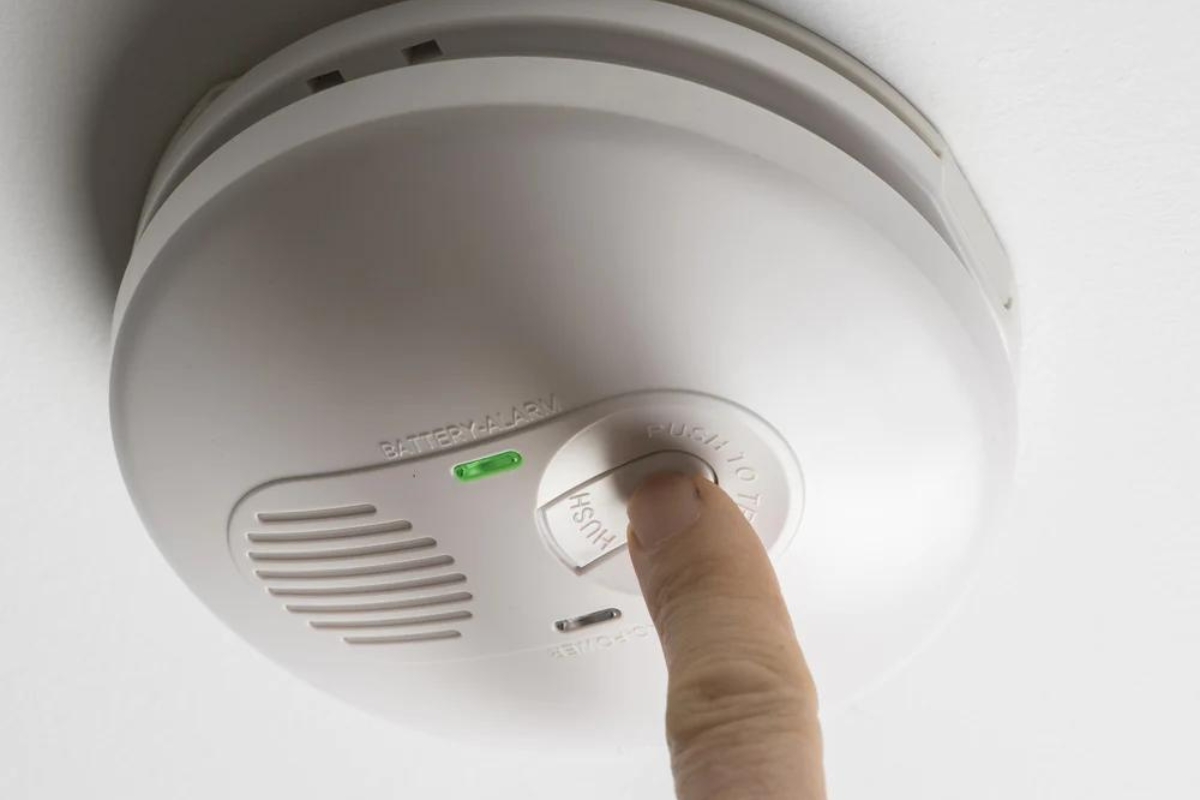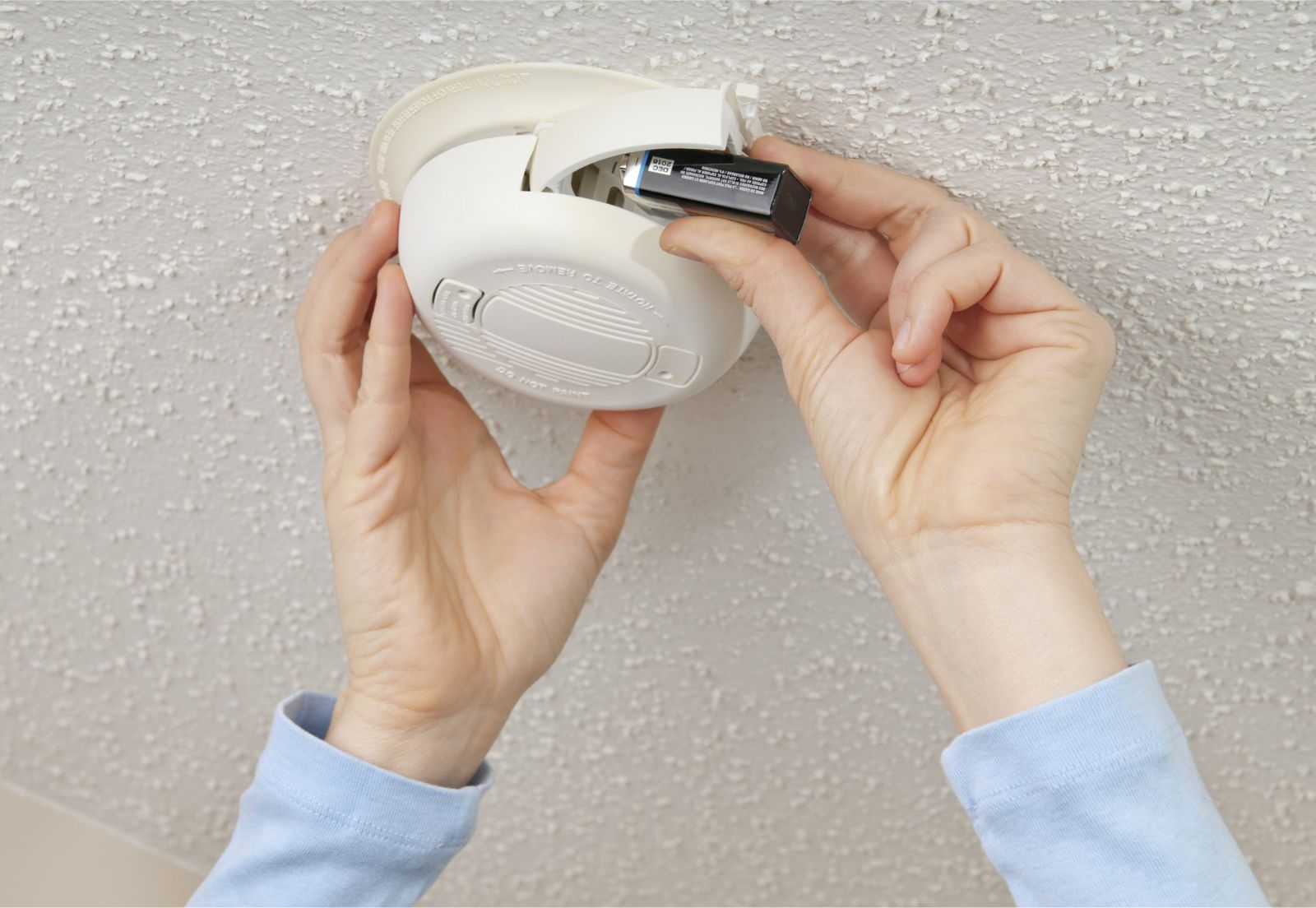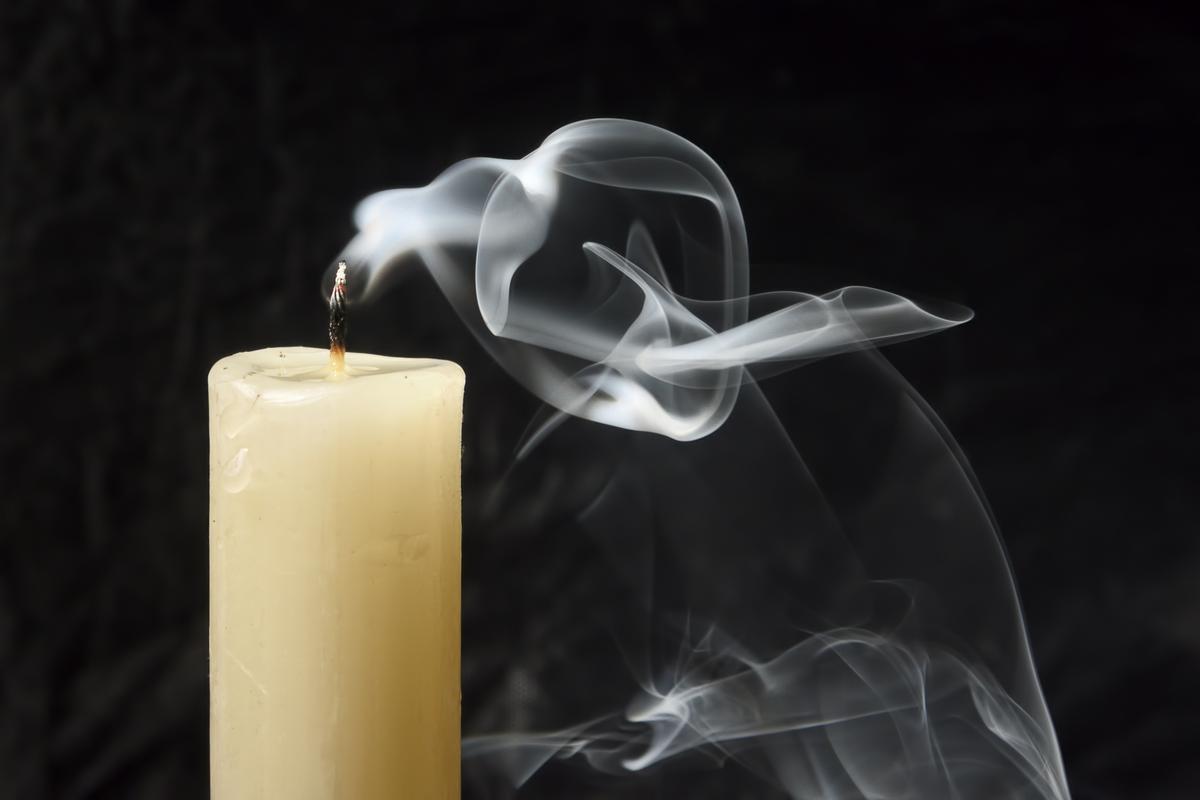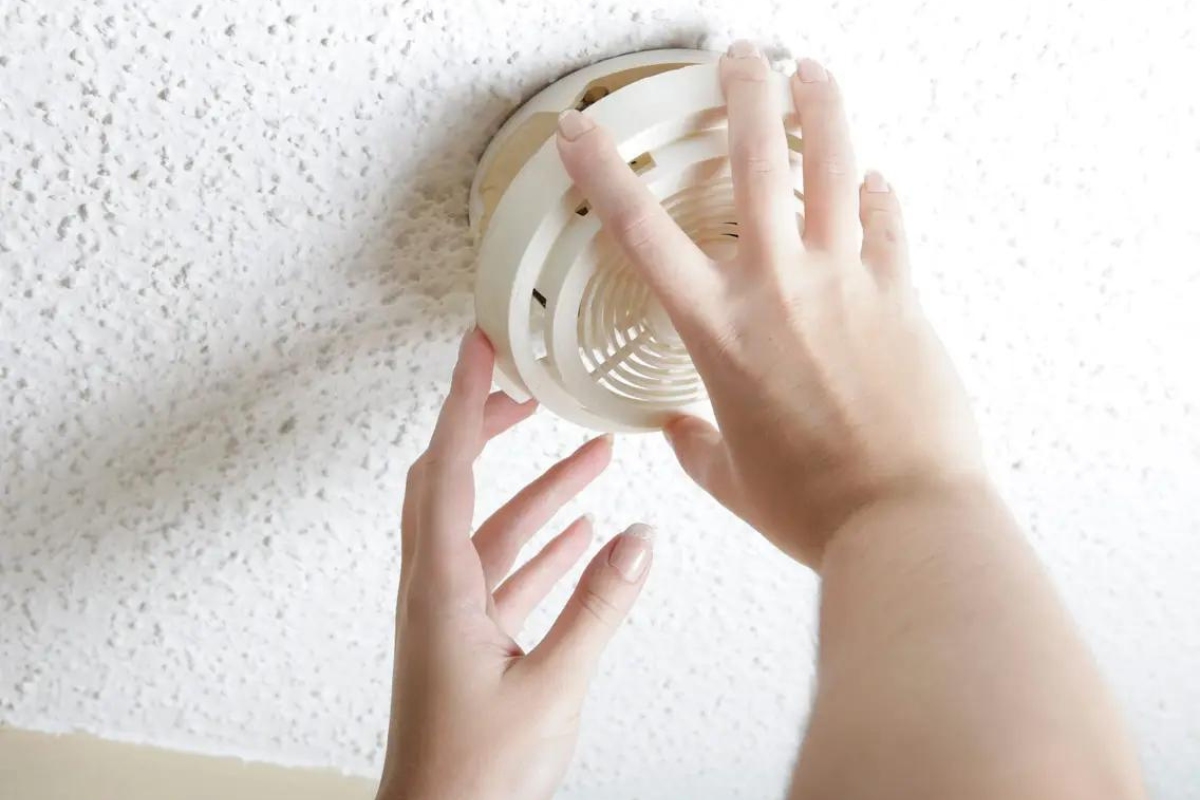

Articles
How To Stop Smoke Detector From Going Off
Modified: January 6, 2024
Looking for articles on how to stop your smoke detector from constantly going off? We've got you covered with practical tips and solutions to prevent those irritating false alarms.
(Many of the links in this article redirect to a specific reviewed product. Your purchase of these products through affiliate links helps to generate commission for Storables.com, at no extra cost. Learn more)
Introduction
Smoke detectors are a crucial component of every home’s safety system. They provide early warning in the event of a fire, allowing occupants to evacuate quickly and safely. However, it can be incredibly frustrating when your smoke detector goes off due to a false alarm. The piercing sound can be disruptive, especially when it happens at inconvenient times, such as in the middle of the night or during a busy day.
In this article, we will explore the common causes of false alarms and discuss effective methods to stop smoke detectors from going off unnecessarily. By understanding the reasons behind false alarms and implementing the right solutions, you can ensure that your smoke detectors operate as intended, providing reliable and accurate fire detection.
Whether you’re dealing with a smoke detector that goes off while cooking, is triggered by steam or humidity, or is affected by dust and insects, we will share practical tips and strategies to address these issues. Additionally, we’ll discuss the importance of proper smoke detector placement, regular maintenance, and the need to replace outdated or malfunctioning detectors.
By following the guidance in this article, you can minimize false alarms, improve the efficiency of your smoke detectors, and have peace of mind knowing that your home is well-protected against fire hazards.
Key Takeaways:
- Minimize false alarms by ensuring proper smoke detector placement, regular maintenance, and addressing common causes such as cooking-related issues, steam interference, and dust accumulation.
- Adjust smoke detector sensitivity cautiously, replace outdated detectors, and follow manufacturer’s guidelines for optimal fire detection and home safety.
Read more: How To Stop A Smoke Detector From Chirping
Understanding Smoke Detectors
Smoke detectors are designed to detect the presence of smoke particles in the air. They are typically composed of two types: ionization and photoelectric detectors. Ionization smoke detectors work by using a small amount of radioactive material to ionize the air inside the detector chamber. When smoke particles enter the chamber, they disrupt the electrical current, triggering the alarm. On the other hand, photoelectric smoke detectors use a light source and a sensor to detect smoke particles. When smoke enters the detector, it scatters the light, which is detected by the sensor, leading to an alarm activation.
Both types of detectors are effective in detecting smoke, but they may have different sensitivities to different types of smoke particles. Understanding how your specific smoke detector works can help you troubleshoot false alarms effectively.
It’s worth noting that smoke detectors can be interconnected, meaning that when one detector detects smoke, all detectors in the interconnected system will also sound the alarm. This interconnected feature is crucial in providing early warning throughout the entire house.
Additionally, smoke detectors may have different power sources, such as battery-operated or hard-wired with battery backup. It’s essential to ensure that your smoke detectors have a reliable power source and regularly test the batteries to ensure proper functionality.
Now that we have a basic understanding of how smoke detectors work, let’s dive into the common causes of false alarms and how to prevent them, starting with the proper placement of smoke detectors in your home.
Common Causes of False Alarms
While smoke detectors are essential for detecting real fire emergencies, they can also be triggered by various factors, leading to false alarms. Here are some common causes of false alarms and how to address them:
1. Cooking-Related False Alarms:
One of the most frequent causes of false alarms is cooking-related activities. Smoke detectors can be triggered by excessive smoke or steam generated while cooking. The best way to prevent false alarms during cooking is to ensure proper ventilation in your kitchen. Open windows, use exhaust fans, or install a range hood to redirect smoke and steam away from the smoke detector. Alternatively, consider installing a heat detector in the kitchen area to supplement the smoke detector without the risk of false alarms.
2. Steam and Humidity Interference:
Excessive steam from hot showers, baths, or humidifiers can also trigger smoke detectors. To reduce steam interference, ensure proper ventilation in bathrooms, use exhaust fans, and keep bathroom doors closed while bathing. It’s also crucial to place smoke detectors away from these areas, maintaining a reasonable distance to minimize false alarms.
Read more: How To Stop Smoke Detector From Beeping
3. Dust and Insect Issues:
Accumulated dust or insects can interfere with the proper functioning of your smoke detector and cause false alarms. Dust particles can obstruct the sensors, while insects may trigger the alarm by crawling inside the detector. Regularly clean your smoke detectors using a soft brush or a vacuum cleaner with a brush attachment to remove dust and debris. Additionally, ensure that the detector’s cover is securely in place to prevent insect entry.
4. Smoke Detector Sensitivity:
Smoke detectors come with adjustable sensitivity settings. If you are experiencing frequent false alarms, reducing the detector’s sensitivity level may help. However, be cautious while adjusting the sensitivity as setting it too low can compromise the detector’s ability to detect real fires. Refer to the manufacturer’s instructions for guidance on adjusting the sensitivity settings correctly.
By addressing these common causes of false alarms, you can significantly reduce the occurrence of unnecessary alarm activations. In the next sections, we’ll explore additional strategies such as proper placement, regular maintenance, and the importance of replacing outdated or malfunctioning smoke detectors.
Proper Placement of Smoke Detectors
The proper placement of smoke detectors is vital for their effectiveness in detecting smoke and providing early warning in case of a fire. Here are some guidelines to consider when placing smoke detectors in your home:
1. Install Detectors in Every Bedroom:
It is recommended to have smoke detectors installed in every bedroom or sleeping area. This ensures that occupants can be alerted promptly, even when they are asleep, giving them ample time to evacuate safely.
Read more: Why Would Your Smoke Detector Go Off?
2. Place Detectors on Every Level:
Smoke detectors should be installed on every level of your home, including the basement and attic, to cover all areas of potential fire risks. This ensures early detection, regardless of where the fire originates.
3. Install Detectors Near Sleeping Areas:
Place smoke detectors near sleeping areas, either inside or just outside the bedroom doors. This helps to ensure that the alarm is loud enough to awaken sleeping occupants, even if the fire is some distance away from the sleeping areas.
4. Avoid Proximity to Vents and Drafts:
Avoid installing smoke detectors near vents, windows, or doors where drafts could affect their performance. Air currents may disperse smoke particles, making it difficult for the detector to accurately detect the presence of smoke.
5. Ceiling Installation:
For optimal performance, smoke detectors are typically installed on the ceiling, as smoke generally rises. However, if ceiling installation is not possible or practical, you can mount the detector on a wall, a few inches below the ceiling and at least 4 inches away from the nearest corner.
6. Follow Manufacturer’s Instructions:
Always follow the manufacturer’s instructions for specific guidance on proper installation and placement of smoke detectors. Different models may have specific recommendations that may vary slightly from the general guidelines.
By adhering to these guidelines, you can ensure that your smoke detectors are strategically placed to provide maximum coverage and efficiency. In the next section, we’ll explore the importance of regular maintenance to keep your smoke detectors functioning optimally.
Regular Maintenance of Smoke Detectors
Maintaining your smoke detectors is crucial to ensure that they function properly and provide reliable fire detection. Here are some essential maintenance tasks to perform regularly:
1. Test Your Smoke Detectors:
Regularly test your smoke detectors to ensure they are working correctly. Most detectors have a test button that you can press to sound the alarm and verify its functionality. Test each detector at least once a month, and if it doesn’t produce a loud alarm, replace the batteries or the entire unit if necessary.
2. Replace Batteries Routinely:
Replace the batteries in your smoke detectors at least once a year or as per the manufacturer’s recommendations. Some detectors have a low battery indicator that will alert you when it’s time to change the batteries. Make it a habit to replace batteries during daylight saving time changes, as it serves as a convenient reminder.
Read more: Why Would Smoke Detector Go Off Randomly
3. Clean and Remove Dust:
Dust and debris can accumulate inside your smoke detectors over time, potentially affecting their performance. Regularly clean the detectors by gently vacuuming or using a soft brush attachment to remove dust from the sensors and vents. Be careful not to damage any components during the cleaning process.
4. Check for Obstructions:
Check the detectors for any obstructions that may hinder their ability to detect smoke. Make sure that the detector’s vents are clear and unobstructed. Avoid placing objects or hanging curtains nearby that could block the airflow.
5. Follow Manufacturer’s Guidelines:
Refer to the manufacturer’s instructions for specific maintenance guidelines and recommendations for your smoke detectors. Different models may have unique requirements, so it’s essential to follow the provided guidelines for optimal performance.
Regular maintenance tasks help ensure that your smoke detectors remain functional and reliable. By performing these maintenance routines diligently, you can minimize false alarms, maximize the efficiency of your detectors, and enhance the safety of your home. In the next section, we’ll address strategies to deal with cooking-related false alarms.
Dealing with Cooking-Related False Alarms
One of the most common causes of false alarms with smoke detectors is cooking-related activities. The smoke and steam generated during cooking can trigger the alarm, leading to unnecessary interruptions. Here are some effective strategies to deal with cooking-related false alarms:
1. Proper Ventilation:
Ensuring proper ventilation in your kitchen is key to reducing false alarms while cooking. Open windows, use exhaust fans, or install a range hood to redirect smoke and steam away from the smoke detector. Having a well-ventilated kitchen helps to dissipate the smoke and reduces its likelihood of reaching the detector.
2. Positioning of Smoke Detector:
If possible, consider placing the smoke detector away from the immediate vicinity of the cooking area. This can help minimize false alarms triggered by cooking activities. However, ensure that the distance is still within the manufacturer’s recommended guidelines for effective detection of real fire emergencies.
3. Use Lids and Splatter Guards:
To prevent excessive smoke and steam from escaping during cooking, use lids on pots and pans. This can help contain the smoke within the cooking vessel and minimize the chances of triggering the smoke detector. Additionally, using splatter guards can help reduce the amount of smoke generated from grease splatters.
4. Properly Clean Cooking Appliances:
Regularly clean your cooking appliances, such as the oven and stovetop, to minimize the chances of smoke and residue buildup. Grease and food particles can contribute to the generation of excessive smoke while cooking. Regular maintenance and cleaning can help prevent false alarms caused by these factors.
5. Consider Alternative Detection Methods:
If cooking-related false alarms persist despite taking preventive measures, consider using alternative detection methods in the kitchen area. Heat detectors or combination heat and smoke detectors can be installed to supplement the existing smoke detectors. These detectors are designed to respond primarily to high temperatures and are less likely to be triggered by cooking activities.
By implementing these strategies, you can significantly reduce the occurrence of false alarms while cooking, ensuring a more peaceful and uninterrupted cooking experience. In the next section, we’ll discuss how to reduce interference from steam and humidity.
Reducing Steam and Humidity Interference
Smoke detectors can sometimes be triggered by steam and high humidity levels in your home. While it’s important not to disable your smoke detectors, there are steps you can take to reduce steam and humidity interference and minimize false alarms. Here are some effective strategies:
1. Proper Ventilation:
Ensure your home has adequate ventilation to allow steam and humidity to dissipate quickly. Use exhaust fans in kitchens, bathrooms, and laundry rooms to remove excess moisture from the air. Proper ventilation helps to reduce the accumulation of steam and humidity, lessening the chances of false alarms.
2. Bathroom Doors and Windows:
When taking a hot shower or bath, keep the bathroom door closed and open a window if possible. This helps to create airflow and prevents steam from spreading into other areas of the house where smoke detectors are located. Opening a window also allows steam to escape, reducing overall humidity levels.
3. Exhaust Fans in Bathrooms:
Make sure your bathrooms are equipped with exhaust fans and use them during and after bathing to remove excess steam and humidity. Run the fan for a few minutes after showering to ensure proper ventilation and to reduce the moisture content in the air.
4. Cooking and Humidity:
While cooking, make use of your kitchen’s exhaust fan to remove steam and humidity from the cooking area. This helps prevent steam from reaching smoke detectors located nearby. If an exhaust fan is not available, consider installing one or opening windows to allow for ventilation.
5. Dehumidifiers:
If you live in an area with consistently high humidity levels, consider using dehumidifiers in your home. These devices help reduce moisture in the air, minimizing potential interference with your smoke detectors. Place dehumidifiers in areas prone to humidity, such as basements or laundry rooms.
By implementing these strategies to reduce steam and humidity interference, you can help prevent false alarms in your smoke detectors. It’s important to maintain a balance between proper ventilation and humidity control to ensure the overall safety and comfort of your home. Up next, we’ll address issues related to dust and insects.
Addressing Dust and Insect Issues
Dust and insects can interfere with the proper functioning of smoke detectors, leading to false alarms. Regular maintenance and addressing these issues are important to ensure the optimal performance of your smoke detectors. Here are some effective strategies to deal with dust and insect issues:
1. Regular Cleaning:
Regularly clean your smoke detectors to remove dust and debris that may accumulate on the sensors. Use a soft brush attachment on a vacuum cleaner or a clean, dry cloth to gently wipe away any dust. Avoid using cleaning solutions or water, as they can damage the detector.
2. Vacuuming the Surrounding Area:
In addition to cleaning the smoke detectors themselves, it’s essential to vacuum the surrounding area to remove dust and debris that could potentially enter the detector. Pay close attention to corners, vents, and any other areas where dust tends to accumulate.
3. Check for Insect Presence:
Inspect your smoke detectors regularly for any signs of insects or bugs. Insects may crawl into the detectors, triggering false alarms. If you find any insects inside the detector, carefully remove them using a soft brush or a small vacuum attachment. Check for any gaps or openings that may be allowing insects to enter and seal them if necessary.
4. Install Insect Screens or Covers:
To prevent insects from entering the smoke detectors, consider installing insect screens or covers. These small screens can be placed over the vents or openings of the detectors to keep insects out while still allowing smoke to enter and trigger the alarm when necessary.
5. Maintain a Dust-Free Environment:
Reducing dust in your home can help prevent dust particles from interfering with your smoke detectors. Regularly dust and clean your home, especially in the areas around the detectors. Use air purifiers or filters in your HVAC system to minimize the amount of dust circulating in your home.
By implementing these strategies and maintaining a clean and insect-free environment, you can minimize the chances of false alarms caused by dust and insects. In the next section, we’ll discuss how to adjust the sensitivity of your smoke detectors to reduce false alarms.
Minimizing Smoke Detector Sensitivity
If your smoke detectors are frequently triggering false alarms, you may need to adjust their sensitivity settings. Here are some steps you can take to minimize the sensitivity and reduce false alarms:
1. Consult the Manufacturer’s Instructions:
Refer to the manufacturer’s instructions or user manual to understand if your smoke detectors have adjustable sensitivity settings. Not all models allow for adjustments, so it’s essential to check the specific guidelines for your detectors.
2. Gradually Reduce the Sensitivity:
If your detectors have adjustable sensitivity, start by reducing it gradually. Find the sensitivity adjustment feature, which may be a switch, dial, or button, and adjust it to a lower setting. Test the detectors afterwards to ensure they still respond appropriately to real fire situations.
Read more: How To Turn Off A Smoke Detector
3. Find the Right Balance:
It’s important to strike a balance when adjusting the sensitivity. While reducing the sensitivity can minimize false alarms, setting it too low may compromise the detector’s ability to detect real fires. Aim to find the sweet spot where the detectors are less prone to false alarms while still providing effective fire detection.
4. Test After Adjustments:
After making any changes to the sensitivity settings, thoroughly test the smoke detectors to ensure they still trigger an alarm when exposed to smoke. Use a household smoke detector test spray or perform a controlled burn test in a controlled environment to verify their functionality.
5. Seek Professional Assistance:
If you’re unsure about adjusting the sensitivity settings or continue to experience false alarms despite adjustments, consider contacting a professional for assistance. They can provide expert guidance and ensure that your detectors are properly calibrated.
Remember, adjusting the sensitivity of your smoke detectors should be done with caution. The primary goal is to minimize false alarms while maintaining their ability to accurately detect real fire emergencies. In the next section, we’ll discuss the importance of replacing outdated or malfunctioning smoke detectors.
Replacing Outdated or Malfunctioning Smoke Detectors
Smoke detectors play a crucial role in keeping your home safe from fire hazards. However, like any electronic device, smoke detectors have a lifespan and can become outdated or malfunction over time. It’s important to regularly assess the condition of your smoke detectors and replace them when needed. Here’s what you should consider when replacing smoke detectors:
1. Check the Age:
Smoke detectors typically have a lifespan of 8 to 10 years. It’s important to check the manufacturing date or the expiration date on your detectors to determine if they’ve reached their recommended lifespan. If they have, it’s time to replace them, even if they seem to be functioning properly.
2. Malfunctioning Detectors:
If your smoke detectors are malfunctioning, such as emitting false alarms consistently or not sounding when there’s a real fire, it’s crucial to replace them. Malfunctioning detectors cannot provide reliable fire detection and may compromise your safety.
3. Upgrading to Newer Models:
Consider upgrading your smoke detectors to newer models that offer advanced features or improved technology. For example, some modern smoke detectors may have interconnected capabilities, allowing them to communicate with each other and provide simultaneous warnings throughout your home.
4. Battery-Powered vs. Hardwired Detectors:
Determine whether you want battery-powered smoke detectors or hardwired ones. Battery-powered detectors offer flexibility in terms of placement and are not affected by power outages. On the other hand, hardwired detectors are directly connected to your home’s electrical system and typically have battery backup capabilities in case of power failure.
5. Follow Installation Instructions:
When replacing smoke detectors, carefully follow the manufacturer’s instructions for installation. Pay attention to proper placement and recommended maintenance practices to ensure optimal performance.
6. Test and Regularly Maintain New Detectors:
After installing new smoke detectors, test them to ensure they’re functioning correctly. Regularly test the detectors, replace batteries as recommended, and perform routine maintenance to keep them in optimal condition.
By regularly assessing the condition of your smoke detectors and replacing outdated or malfunctioning ones, you can ensure that your home is equipped with reliable and effective fire detection technology. In the concluding section, we’ll summarize the key points discussed in this article.
Conclusion
Smoke detectors are essential for the safety of your home and loved ones, providing early warning in the event of a fire. However, dealing with frequent false alarms can be frustrating and disrupt your daily routine. By understanding the common causes of false alarms and implementing effective strategies, you can minimize false activations and ensure the reliable performance of your smoke detectors.
We discussed the importance of proper smoke detector placement, emphasizing the need for detectors in every bedroom, on every level of your home, and near sleeping areas. We also explored how to address common causes of false alarms, such as cooking-related issues, steam and humidity interference, dust and insect problems, and excessive sensitivity.
Regular maintenance is key to the optimal functioning of smoke detectors. We covered important maintenance tasks, including testing your detectors, replacing batteries, cleaning them to remove dust and debris, and checking for any obstructions or insect presence. These practices help ensure that your smoke detectors can effectively detect smoke and minimize false alarms.
If false alarms persist despite implementing preventive measures, you may need to adjust the sensitivity of your detectors. However, it’s crucial to find the right balance between sensitivity and accurate fire detection. Consulting the manufacturer’s instructions and conducting regular testing are essential steps when adjusting sensitivity settings.
Lastly, we discussed the importance of replacing outdated or malfunctioning smoke detectors. Checking the age of your detectors and upgrading to newer models can enhance the overall effectiveness of your fire detection system.
By following these guidelines and taking appropriate actions, you can reduce false alarms, maximize the efficiency of your smoke detectors, and ensure the safety of your home and family. Remember to regularly maintain and test your detectors to ensure their proper functioning at all times.
Stay vigilant, stay safe, and protect what matters most!
Frequently Asked Questions about How To Stop Smoke Detector From Going Off
Was this page helpful?
At Storables.com, we guarantee accurate and reliable information. Our content, validated by Expert Board Contributors, is crafted following stringent Editorial Policies. We're committed to providing you with well-researched, expert-backed insights for all your informational needs.




0 thoughts on “How To Stop Smoke Detector From Going Off”